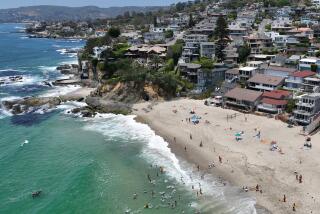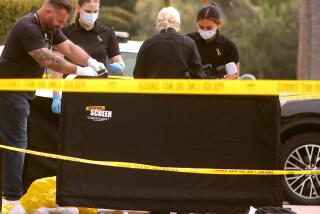This Time, Huntington Keeps It to a Dull Roar
- Share via
HUNTINGTON BEACH — Helicopters thumped overhead and police swarmed downtown in a remarkable show of force Thursday as Surf City sought to celebrate the Fourth of July without the holiday violence that had become the city’s unwanted trademark.
Police arrested more than 300 people for a variety of violations and used loudspeakers to disperse crowds of revelers from a downtown stretch of Main Street where boisterous groups were tossing firecrackers at each other and starting fistfights. Amid taunts and cheers, twin rows of police in riot helmets swept more than 1,000 people out of downtown.
Squads of officers swooped down on clusters of party-goers who set off firecrackers in the street and raced to stamp out small but scattered debris fires near downtown.
The result of the crackdown seemed to be what authorities were hoping for: The disturbances were less serious than those that had marred previous Fourth of July celebrations.
“The main difference is the overall feeling of the night,” Police Lt. Dan Johnson said. “Last year was ugly. The year before was ugly. This time, I believe, people felt they could walk downtown and not feel in danger.”
Resident Rahim Munshi agreed.
“You definitely feel safe,” said Munshi, 42, attending the city’s fireworks show with his family. “It’s a lot different than last year. There’s not so many gang types. We think it’s great.”
More than 200 police officers patrolled Huntington Beach by air and land to prevent a repeat of the violence that had become a troubling holiday ritual. Virtually every officer in the city was on duty and security plans included roving SWAT teams and barricades to keep cars and bicycles from a 100-square-block area where partying has exploded into trouble the past three years. The Huntington Beach Pier was also closed off Thursday evening to keep crowds from gathering there.
Police said that by 10 p.m., more than 300 people had been arrested for a variety of violations, almost all of the misdemeanors related to drinking in public. Johnson estimated that the nighttime crowds at about half of those last year, when a Huntington Beach man was shot dead amid the melee.
“If you want to come down and have a good time, that’s fine,” Johnson said. “If you want to come down here and be a punk, we’re going to put you in jail.”
A similarly beefed-up force in Newport Beach closed a stretch of Balboa Boulevard where most of the revelers usually congregate. Pedestrians were allowed through, cars and cyclists were not.
The heavy police presence on beachfront streets kept trouble to a minimum. By 11:30 p.m. there had been 50 arrests, “mostly for drunk and disorderly conduct,” Newport Beach Police Lt. Doug Fletcher said.
“It’s a controlled riot,” said Scott Edwards, 21, of Santa Ana. “The cops have been totally cool.”
In Huntington Beach, memories of last year’s deadly mayhem were as immediate as the constant din of police helicopters overhead. Officers were planted at every downtown street corner--an unprecedented presence that might have played a role in the unusual quiet along Main Street. Motorcycle police were out in force while other officers rode on the backs of vans used to haul away arrestees.
“It’s like Independence Day under martial law,” said Lloyd Johnson, 35, a downtown resident who watched a crowd set fire to a couch in a neighbor’s yard during last year’s revelry. He said the police did too little to avert last year’s trouble, but went overboard Thursday.
“Every year they try something new, but they seem to go too far one way or the other,” Lloyd Johnson said.
*
In a departure from last year’s plans, police did not seek early closure of the shops and restaurants that make up the heart of Huntington Beach’s downtown. This time, authorities hoped the foot traffic would create a calming “family atmosphere.”
John and Shari Trampush, former residents who moved from Huntington Beach last year in part because of the July 4 mayhem, brought their two children to watch the fireworks. But the Anaheim Hills couple planned to leave soon after the show.
“That’s when things get out of control,” said Shari Trampush. “People have been partying all day and you have good drunks and you have bad drunks. And the bad drunks ruin it for everybody.”
Even with the police crackdown, many Main Street merchants were closing early.
At Hurricane’s Bar and Grill, a normally bustling spot for night life, the band played instead during the afternoon so doors could close at 8 p.m.
“That’s when the sun goes down and the witching hour begins,” bar manager Mitch Bailey said.
But the tight security, which kept even skateboarders and roller-skaters from entering downtown, left plenty of locals unhappy.
Huntington Beach resident Alan Love pedaled his bike toward Main Street until he was stopped at the police barricade. No bikes allowed, he was told. Perhaps he should just pedal on home.
Dejected, Love was doing just that.
“I can’t believe it,” said Love, 28, as he steered his bike away. “I’ve never seen so many police down here.”
*
At a party a few blocks away, host Pat Downey was decidedly grumpy about the tightened restrictions, which he said kept guests from driving into the neighborhood and even forced cancellation of his neighborhood’s annual water-balloon fight.
Downey, wearing an Uncle Sam hat and a Stars and Stripes T-shirt, tacked signs on a tree declaring his yard a “DMZ” from “martial law.”
Police “have a job to do,” huffed Downey, 60. “But they just don’t have to do it so enthusiastically.”
Denise DeVines said her family got a rude surprise from police after arriving at her son’s house on 19th Street for a cookout. The son and a friend were arrested while setting up a Ping-Pong table on the front yard. The reason, she said, was that the two were holding beers.
“As this was happening, my son’s wife popped her head out the front door, not knowing what was going on and asked, ‘Does anyone need a beer?’ So they arrested her too, and she doesn’t even drink,” DeVines said. “She was just trying to be a good hostess.”
At 10:30 p.m., DeVines said her son and his friend were still in custody.
The party scene in Newport Beach featured jammed nightclubs, crowded apartments, throbbing music; scantily clad men and women on skates.
A stream of people carrying CDs, amplifiers, speakers, cases of alcohol and party gear streamed out of a house near 29th Street and Balboa Boulevard.
“We are one step ahead of a cops,” said a man in his 20s. “We have so many friends in Newport that we are moving the party two blocks away.”
It was such roving bands of revelers who Huntington Beach police said were the chief mischief-makers during recent July 4 melees.
Mayhem that broke out late in the evening of July 4 last year left a man fatally shot and two others with stab wounds and ended with more than 100 arrests for a variety of offenses. In 1994, rowdy crowds burned furniture in the street and tossed firecrackers, bottles and rocks at police officers and passing motorists. Nearly 150 arrests were made. Clashes spawned complaints that baton-wielding police attacked bystanders, but Police Chief Ronald E. Lowenberg defended the conduct of his officers, saying they were under assault.
Ken Elliott, a 27-year-old college student who said he was arrested last year, toted a video camera to tape police officers “just in case an injustice occurs.”
He said police seemed to be picking on people with long hair or unconventional appearances.
“They’re sending the message that they want you to stay in your home,” Elliott said.
Not everyone was displeased with the police show of force.
Shortly after arresting a young woman on suspicion of public drinking, one of the officers turned his attention to another task: handing out foil badges to a pair of youngsters nearby. Amid all the hubbub, the stickers were a hit with Hayden Owen and Kaitlin Hall, both 8.
“I’m never going to be an officer,” Hayden said. “But I got no problem with them.”
Also contributing to this report were Times staff writer Michael G. Wagner and Times correspondent Enrique Lavin.
More to Read
Sign up for Essential California
The most important California stories and recommendations in your inbox every morning.
You may occasionally receive promotional content from the Los Angeles Times.













